
JAKE DAVIS
(born ca.1893 – May 1981)
Vancouver East End (1909-1911)
Vancouver Athletic Club (1912-1914)
Victoria Foundation Club (1919)
Vancouver Terminals (1920; 1921-1923)
Vancouver Lacrosse Club (1921)
Jake Davis was born in Toronto but moved to Vancouver when he was just a tiny child. He played junior lacrosse for two years with the East End club before turning senior with the Vancouver Athletic Club in 1912.
The Athletics had won their Mann Cup challenge the year before when they defeated cup holders Young Torontos in a two-game, total goal series 9-3. The young rookie Jake Davis soon found himself part of the new senior amateur dynasty team taking root in Vancouver, defending their hold over the cup against all challenges in 1912 and 1913 – and gaining a reputation as an outstanding, young lacrosse goalkeeper. His older brother Bill Davis also played for the Vancouver Athletic Club, up front as a midfielder, during their Mann Cup years.
In the 1914, the core group of VAC players felt there was nothing else to achieve by remaining in the senior amateur game, so the team joined the professional ranks in the British Columbia Lacrosse Association league with their desire to step up to the next challenge and wrestle the Minto Cup away from the New Westminster Salmonbellies. However, the club refused to let Jake Davis turn pro as they still wanted to defend the Mann Cup and required his services in goal. During the defense of their Mann Cup challenges that year, he played with cracked ribs – tearing off bandages during a game when they began to interfere and hinder his play.
Mann Cup play that year would become bogged down by disputes. The Athletics had defeated the Calgary Chinooks and Brampton Excelsiors in challenge matches but then the Mann Cup trustees disputed the status of one of the Vancouver players in the series versus Brampton.
Despite the views of British Columbia lacrosse, national lacrosse and amateur athletic organisations that supported Vancouver’s position, the trustees instead awarded the cup to the Calgary Chinooks on September 29, 1914. Vancouver however held on to the gold trophy and refused to turn it over to either the trustees or the Chinooks. Finally, resolution to the issue came on December 7, 1914, when the Canadian Amateur Lacrosse Association overruled Mann Cup trustee Joseph Lally and awarded the cup to the Vancouver Athletic Club.
Jake Davis married at a young age around 1913 and the couple would later have four sons. As well as lacrosse, he also played soccer and ice hockey, both in goal, and was a shortstop in baseball.

The Great War would put a hold over Jake Davis’s lacrosse career, although he did participate in some of the patriotic charity fund-raising matches organised during the war years.
When formal play resumed in 1918, Davis joined the Vancouver Coughlans Shipyards team in the Vancouver Amateur Lacrosse Association. After besting the cup-holders New Westminster Salmonbellies in league play and defeating the North Vancouver Squamish Indians 6-4 in a single-game playoff, the Coughlans then won (or retained) the Mann Cup by defeating the Winnipeg Argonauts.
The following year he joined the Foundation Lacrosse Club founded by ‘Cotton’ Brynjolfson in April 1919 to represent the Victoria Shipyards – and Davis would add his final Mann Cup crown, won with his third team, to his name that season.
1920 saw Jake Davis finally turn professional and sign with the Vancouver Terminals, in the process pushing out veteran keeper Dave Gibbons in what could be viewed as a changing of the guard. Unlike their Salmonbellies rivals, the various Vancouver teams did not boast the same numerical depth of local trained talent in goal. In lieu of Eastern imports, Gibbons and Davis were by far the best goaltenders to come up through the ranks of Vancouver organisations for the first-quarter of the 20th century – and Gibbons’s best years were now behind him when Jake made the step up to the pro game in 1920.
When Con Jones started up the rival Pacific Coast Lacrosse Association, he recruited Jake Davis for his Vancouver Lacrosse Club. When the second league folded a few weeks into its season, Davis then jumped back to his former Terminals club – and for a second time, pushed out Dave Gibbons from the starting spot between the pipes.
During the 1922 season he missed some games from an abdomen injury when he was butt-ended by a stick on the sly during a game versus New Westminster. The following year Jake Davis went “South” in August 1923 and quit the Vancouver Terminals in mid-season, moving to California along with his father and becoming a carpenter there.
The relocation became permanent in 1930 when he was hired by Mobil Oil. He worked for the oil company for 31 years and retried as the plant yard foreman in 1961. He lived in Berkeley until retirement and then moved to Richmond Heights a year later. At the time of his hall of fame induction in 1977 he was residing in Long Beach, California.
In November 1946, Davis wrote to the Vancouver Sun asking for contact information for ‘Newsy’ Lalonde as well as for any lacrosse films available to show in California. He also wrote a letter to the Victoria Colonist newspaper in October 1969, asking “to find out if any of the [Foundation] boys are still living”. Otherwise, he had disappeared off the radar of the old lacrosse fans and the press, so much so it was not even known if he were still alive or not by the time he finally returned to Vancouver around 1973-74, visiting the city for the first time since moving to California in the 1930s. His arrival and subsequent meeting with one of the local sports reporters sparked the move to get him finally inducted into the Canadian Lacrosse Hall of Fame in 1977 – although with hindsight and the benefit of research, it appears his legacy and his legend had become misreported, blurred, and more so, embellished over time.
“Eight straight Canadian championship teams between 1912-1920”, as reported in the Vancouver Sun in 1977 at the time of his induction, is a falsehood, along with the claims of “seven Mann Cup winning teams” and “first Minto Cup shutout in 1912”.

So much emphasis was placed in 1977 on this lone shutout that he was even bestowed the nickname “Mr. Zero”. This moniker is completely unwarranted. While shutouts were rare during the professional field era, they were not unique nor unheard of – with 8 shutouts occurring in professional play on the Pacific Coast: 2 each by Alban ‘Bun’ Clark, Alex ‘Sandy’ Gray, and Bernie Feedham, and one each by Dave Gibbons and Jake Davis (in 1923 – not 1912). It seems, however, with the benefit of time, the passing of observers, and the complete lack of statistical information in 1977, Jake Davis became the only goalkeeper who was remembered by such a performance and his career subsequently became memorialised by it.
When examining his championship wins, there is much more factual truth there. In the challenge era for the Mann Cup and Minto Cups, it can be quite difficult to determine and tabulate totals as some seasons did see multiple challengers as well as league play also factoring who the cup holders were. Jake Davis won, retained, or defended the Mann Cup during league play over the course of five seasons, to which can be added another six successful challenge victories. However, in 1915 the Athletic Club dynasty was finally broken when the Mann Cup was won by New Westminster. This and the two-year gap on account of the war broke the so-called succession of straight championships. His lone Minto Cup championship came in 1920, his last hurrah on a championship team. Despite the grand claim of “eight straight Canadian championship teams between 1912-1920”, his six years of championship seasons in less than a decade is nevertheless impressive.
Compared with other goaltenders from the professional era on the Coast, Davis would be ranked third for most career wins (27), tied fifth for career winning percentage (.500), and sixth for career goals against average (5.00) – with some of those placements ahead of him held by a few emergency players having to go in goal in one-off starts. At the professional level, he was certainly a very capable and reliable goalkeeper but nowhere near the outstanding figure that later press (or the hall of fame press) made him out to be – although to be fair, his performance during his senior years spent with the Vancouver Athletic Club seems to be by what he was remembered most for, and it can be argued that he was probably the best amateur keeper on the Pacific Coast in the 1910s. Over time, aged minds likely blurred his full career and results all together.
Just for the record: his ‘famous’ shutout occurred on June 9, 1923 in a 2-0 decision at Queens Park, coming two weeks after New Westminster goalkeeper Bernie Feedham himself had blanked the Terminals 1-0.
(PHOTO SOURCES: Victoria Colonist October 29, 1969; CLHOF X979.190.1 excerpt; CVA 99-1019 excerpt)

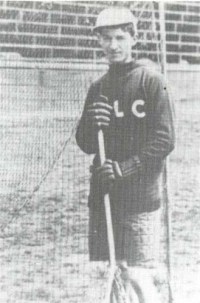
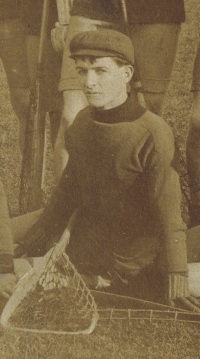

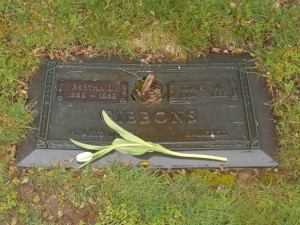
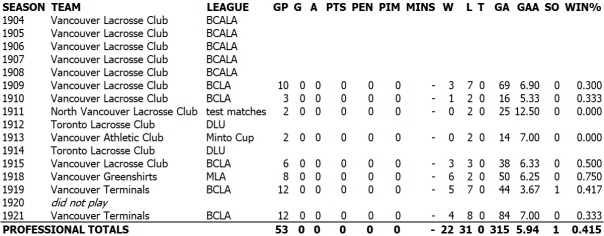
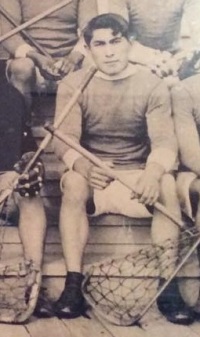
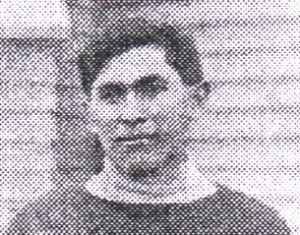


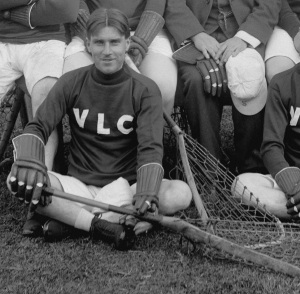


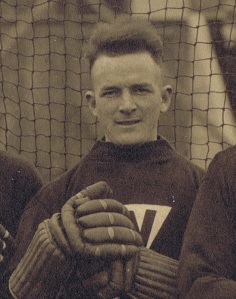
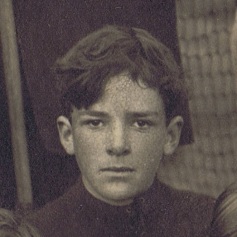

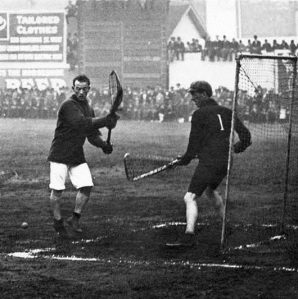
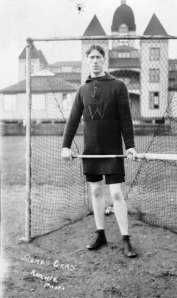





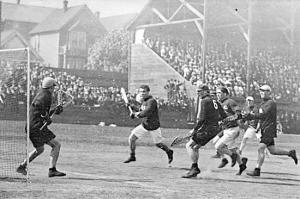

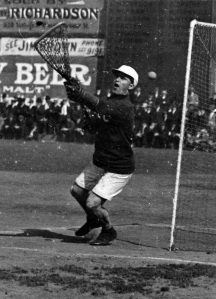
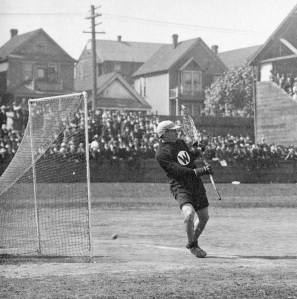
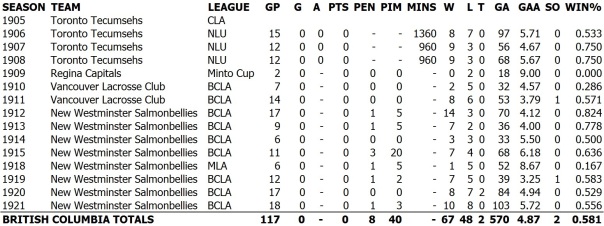
You must be logged in to post a comment.